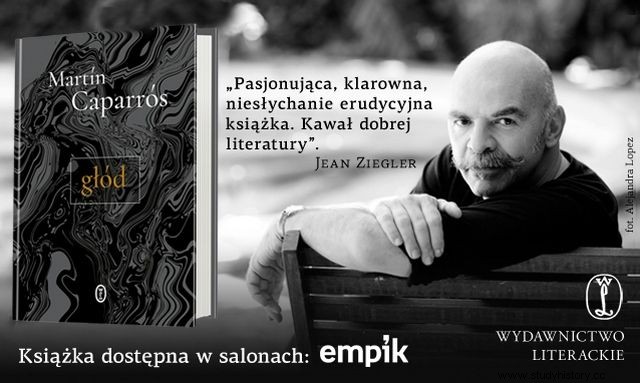Children - pale and silent like fish, adults - weak and slender like a rose. 50,000 deaths caused by hunger each year. Life expectancy:less than 30 years. This is what the lives of millions of Poles looked like less than 150 years ago.
25,000 every day - so many people die of hunger in the world today. As Martín Caparrós writes in his book, published in Poland, that hunger after centuries of presence that is visible to everyone, also in the so-called civilized world, has passed into the world of phenomena that are only shown on TV as stories about someone else .
Let's go back a century and a half. Distant times, but not necessarily places:Galicia, mid-nineteenth century. More than one misfortune then fell on this land, but each ended in hunger. Stanisław Szczepanowski, a 19th-century researcher of Galician poverty, sadly concluded:
I was not able to find, either in Europe or Asia, a country where less food was produced per head, where the food was worse and less poor, as in Galicia (...) Every Galicyan works for half a man and eats for a quarter.
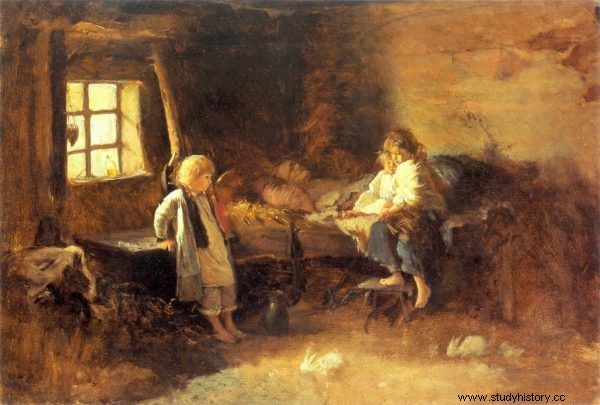
In the second half of the 19th century, famine in Galicia killed up to 50,000 people a year! The illustration shows the painting by Aleksander Kotsis "Matula have died" (source:public domain).
There was neither parochial emphasis in it (the author had studied and worked in Western Europe), nor rhetorical exaggeration. Szczepanowski described Galician poverty using numbers. It was a picture of a land of hunger, poverty and despair.
Ghosts, fish and mountains of horse carcass
The Ukrainian writer and social activist of that time, Ivan Franko, listed at least six major famines that had passed through Galicia since 1847.
Probably the biggest of them came after the summer of 1889. There was a shortage of oats, hay, beet and potatoes. The peasants were forced to get rid of below-value herds because they had nothing to feed it. Horses were massively killed in winter, but despite starvation or deaths from exhaustion, their meat was not eaten.
The press appeals of the authorities to include horse meat in the diet did not work, because the peasants generally could not read, and more importantly:the Church categorically opposed it . Mountains of unburied horse carcass lay in the fields and forests.
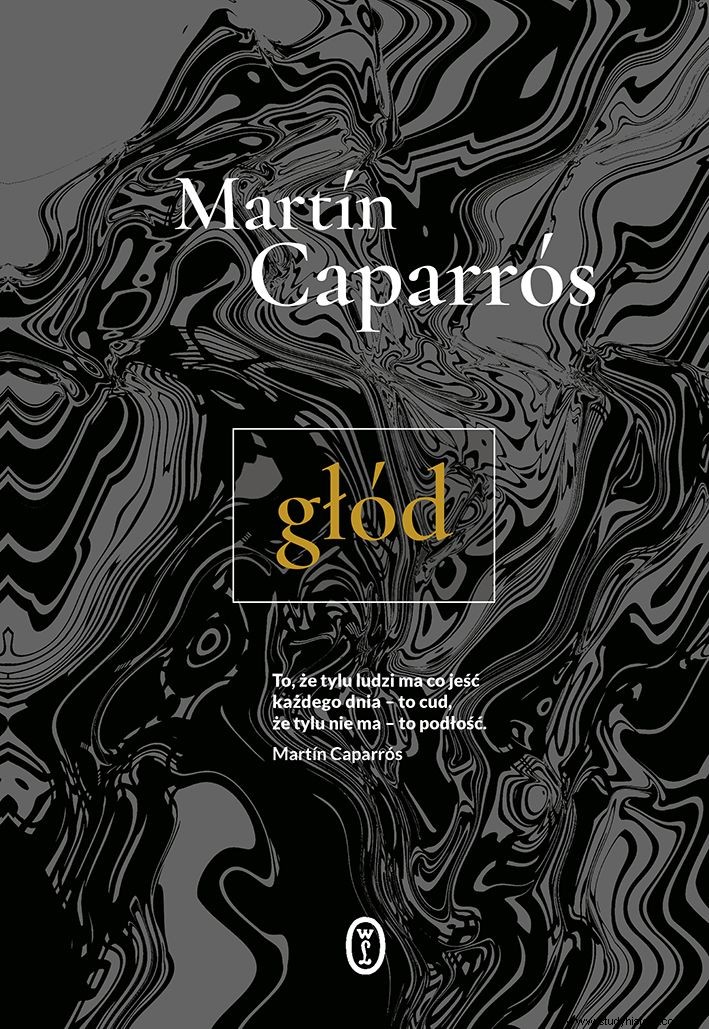
The article is based on, among others, the book by Martín Caparrós entitled "Hunger" (Wydawnictwo Literackie 2016).
After visiting a village, a correspondent from Kurjer Lwowski wrote that people roamed the area like ghosts, and children were pale and silent, like fish .
It is not known how many inhabitants of Galicia died during that time - but Szczepanowski not much earlier estimated that of hunger, diseases and infections caused by malnutrition in these areas at least 50,000 people a year! Life expectancy was 27 years for a man and not much more for a woman.
The people were fed worse than the English paupers
The peasantry found themselves in a hunger vicious circle. Galicyanin feeds poorly, so he works poorly; he cannot eat better, because he works too little and dies early, because he feeds poorly - Szczepanowski wrote.
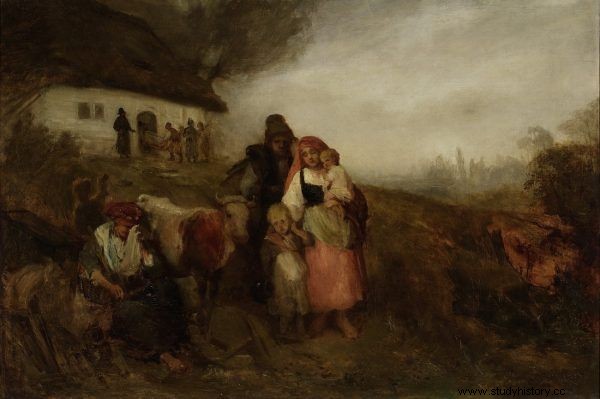
In the 19th century, Galician peasants lived on the verge of starvation. In the illustration, the painting by Aleksander Kotsis "Without a Roof" (source:public domain).
Peasants usually ate the same day after day:groats, bran, broad beans, cabbage - but not necessarily bread, because wheat and rye were sold. There was milk only in summer, because in winter it was impossible to milk malnourished cows. Meat - only when a cow has died or a pig has been slaughtered on a great holiday. More valuable food was exchanged for clothes or shoes.
Water boiled with flour, groats boiled with turnips or carrots, potatoes (if they were successful), linseed oil were the only omega - mentioned Stanisław Pigoń, later a famous historian of Polish literature, who came from a peasant family in Podkarpacie. People after such a digest were emaciated, and towards spring, after a great fast, weak and flaccid, as it returned - mentioned.
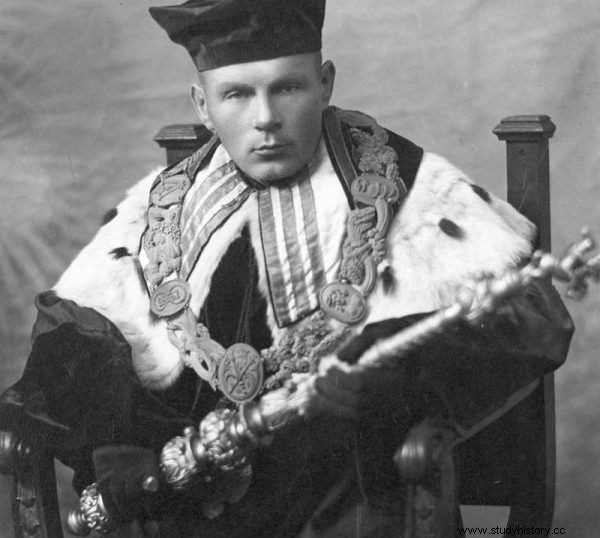
Professor Stanisław Pigoń, as a peasant son from Podkarpacie, experienced Galician poverty firsthand (source:public domain).
Inhabitants of Galicia they ate more than twice as much grain and meat as the citizens of other countries . Our people are much worse fed than the poor of England, [kept] from public funds - Szczepanowski claimed.
One sheepskin per family
Life was more expensive and earned less than in other countries of the Austrian monarchy. The level of illiteracy was highest. In the villages, people lived in one-room huts with tiny windows to make it easier to heat them. Often part of the room was a stable.
This article has more than one page. Please select another one below to continue reading.Attention! You are not on the first page of the article. If you want to read from the beginning click here.
The children had no pants or shoes - they ran barefoot until late fall in a single linen shirt. There was only one sheepskin coat and a pair of shoes for the whole family, so only one person was allowed to leave the house in winter.

Hunger and disease took their toll in 19th century Galicia every year. The illustration shows a drawing by Bronisław Kamiński "The Misery of a Farmer" (source:public domain).
Hygiene was limited to spraying the face with water, so tuberculosis, typhus, smallpox spread - especially in Ukrainian-inhabited Eastern Galicia, and cholera epidemics occurred in some areas almost every year .
After serfdom was abolished in 1848, the land was parceled out in such a way that the peasants received plots - usually too small to provide fodder for even one cow, let alone support the family by farming. Such a "half-host", as he was called, was forced to indebted to the moneylenders "for the future harvest," whether it was agricultural crops or tools.
Vodka, angels and delicate meat
Drunkenness was spreading - the landowners, in view of problems with the sale of grain, benefited mainly from distilling. The peasants drank vodka, cheap and brewed on the spot, also on credit, finally mortgaging the land and the cottage with the innkeeper.
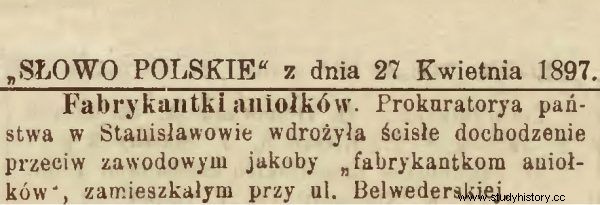
The Galician press regularly reported on the activities of angel factory owners.
Poverty gave birth to further pathologies. Martin Pollack writes about the so-called fabrication of angels - women were not able to feed another child in the family, so they "gave" them to another woman, who killed them for a small fee. Most often - just starving.
Finally:"trade in delicate meat," as it was called in the press at the time. More attractive girls were torn from starving families and taken to brothels in New York, Buenos Aires or Rio do Janeiro. The Polish economist, Leopold Caro, claimed that at the turn of the 19th and 20th centuries, about 10,000 girls were transported from Galicia to South America alone. .
A well-known Jewish pimp, who participated in this practice, believed that it was basically a charity work - because in our country such a stupid wench doesn't even have anything to put in his mouth and has to wear dirty rags .
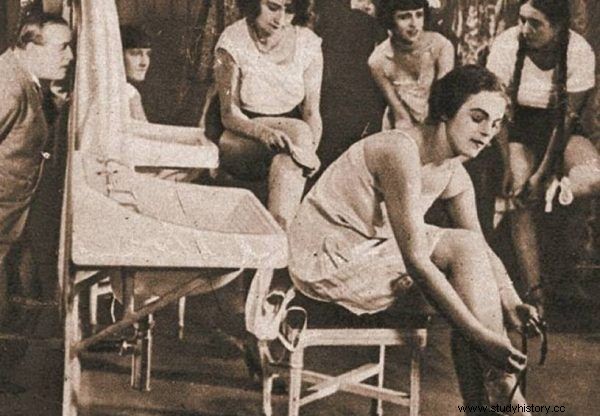
Another face of Galician poverty was the human trade. Tens of thousands of girls from Galicia ended up in brothels on the other side of the Atlantic. The illustration shows a still from the film "The Trail of Disgrace" made in the interwar period, which introduced the viewers to this practice.
All this time, Galicia recorded a positive birth rate - the population grew from four and a half to over seven million. A population that earns so little, is so poor and so poorly nourished, has many more children to support than in other countries - Szczepanowski was saying.
Heir without capital, peasant without shame
How did the notorious "Galician poverty" mature?
The lands which Austria called the Kingdom of Galicia and Lodomeria were lost by the Commonwealth so early that they did not manage to "catch" on the Stanisław reforms. Vienna, on the other hand, seized them too late for the changes of the era of "enlightened absolutism" to arrive here. The empire intended to treat the new province as a colony and, above all, to exploit it. Especially with the help of taxes.
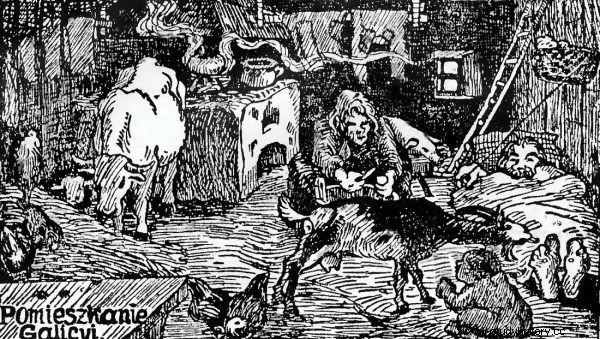
The Austrian authorities treated Galicia almost like a colony. They just wanted to get the most taxes possible from people. No wonder that most of its inhabitants lived in extremely difficult conditions (source:public domain).
Before the partitions, Galicia paid 4 million zlotys to the state treasury, and in 1840 Vienna squeezed over 50 million from it - such data was provided by one of the most important Polish historians of the 19th century, Walerian Kalinka. Taxes were even increased after the liquidation of serfdom. When the landlords had to start paying their former subjects as workers, they were almost drained of capital.
The recent heir could only offer a bad wage and could only count on a bad job. The peasant, on the other hand, who was granted a few acres of land, could get rich only by stealing. This taught him to "do harm without shame" and not to care for his own or other people's land.
This article has more than one page. Please select another one below to continue reading.Attention! You are not on the first page of the article. If you want to read from the beginning click here.
The peasantry dealt with the land as best it could:without worrying about fertilizing, without using crop rotation, with primitive tools in their hands. On the other hand, landowners, even the more thrifty ones, were stuck in an anti-development trap:whatever they earned with their own hard work or saved, they ate taxes or repayment of loans at rogue interest (there were no others).
There is no industry, there is exploitation
At the same time, industry was already thriving in the Kingdom of Poland. The local credit companies borrowed millions of rubles for the construction and commissioning of factories. The Kingdom authorities used deposits for lending activities - meanwhile, Vienna took them into its own cash desk by all possible methods.
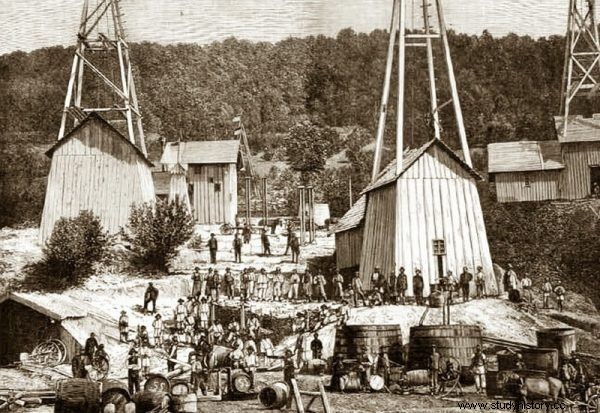
For Vienna, Galicia was a source of cheap raw materials and a market for products manufactured in the more developed parts of the monarchy. This was especially noticeable after the discovery of rich oil fields in Galicia (source:public domain).
Austria's lack of local investments did not bother her, because she saw in the province only a source of raw materials and a market for cheap products from the metropolis . Objects that the smallest foreign town supplies itself, Galicia brings from Vienna - Kalinka complained about the Austrian factory owners' market .
Even at the turn of the 18th and 19th centuries, high grain prices gave Galicia a minimum of economic stabilization. Later it was not only natural disasters - droughts, hail, floods - but also a globalization blow, of which the aforementioned Caparrós writes in the "Hunger":Americans flooded Europe with cheap wheat. A permanent collapse of civilization began for Galicia.

The article is based on, among others, the book by Martín Caparrós entitled "Hunger" (Wydawnictwo Literackie 2016).
Our Lady of New York or emigration
Emigration became a partial salvation for Galician paupers. On the wave of the "great famine" in 1890, thousands of homeworkers and workers moved to the Russian partition to earn their bread. Another direction was the journey across the ocean - most often after illegal recruitment by immigration agents who earned a fortune on this practice.
For example, agents told dark Polish peasants that the Statue of Liberty that would welcome them to America was "Saint Mary, Mother of God, Queen of Poland." Wages in American steel mills or mines (a dollar for a working day) were starving, but for many refugees it was still a fortune compared to what they had to live for in Galicia before - if they saw cash in it at all.
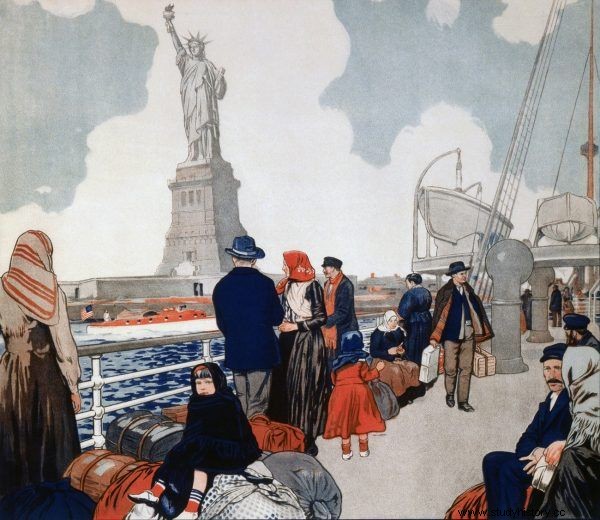
For tens of thousands of Galician paupers, America was a true promised land (source:public domain).
The country was slowly beginning to vibrate when in 1888 Governor Filip Zaleski was replaced by Kazimierz Badeni, associated with the Stańczyk family. The pressure of Polish politicians and their growing influence in Vienna made it possible to start any investment policy. At the end of the nineteenth century, a cooperative movement began - agricultural circles began to create shops, warehouses and wholesalers. Adapting to the new times, landowners also formed partnerships to be able to sell cattle and pigs, among others.
Anyway:the Second Republic of Poland inherited from the "Brightest Ponie Cysorze" a country that had to be raised from the economic and social crisis. Behind the satirical name:"Golitsia i Głodomeria" - there is not a joking story, but a tragic one.
Bibliography :
- Martín Caparrós, Hunger , Wydawnictwo Literackie 2016.
- Mieczysław Czuma, Leszek Mazan, Austrian Talking or the Galician Encyclopedia , Anabasis 2013 Publishing House.
- Zbigniew Fras, Galicia , Dolnośląskie Publishing House 1999.
- Walerian Kalinka, Galicia and Krakow under Austrian rule. Choice of writings , Academic Bookstore 2001.
- Martin Pollack, America's Emperor. The Great Escape from Galicia , Black 2011.
- Stanisław Szczepanowski, Poverty of Galicyi in figures and a program of energetic development of the national farm , Gubrynowicz and Schmidt 1888.
You can buy Martín Caparrós' book at a discount at empik.com
